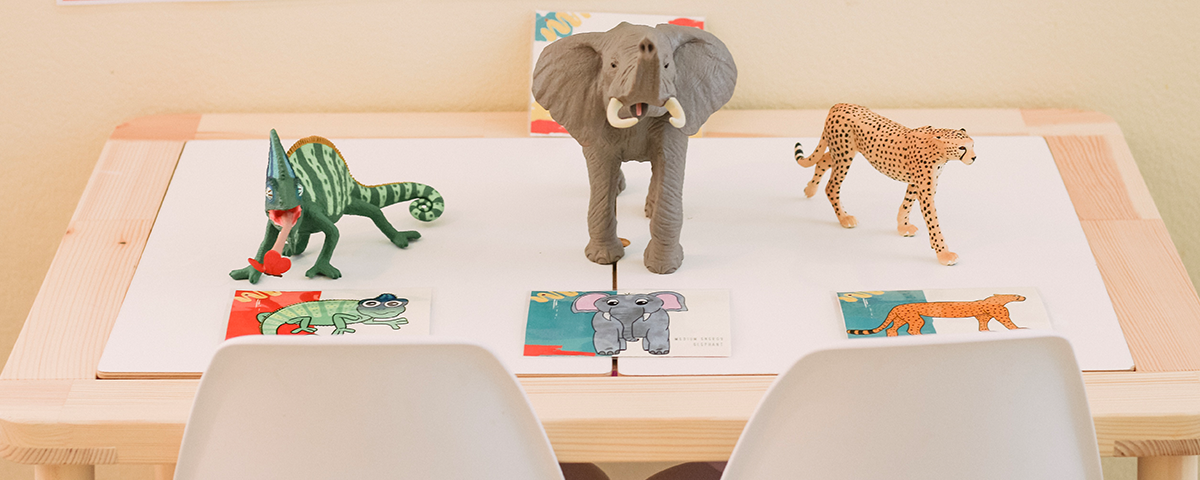
Using Energy Checks to Further Development
You probably have heard of energy checks before, but you may not know how helping children identify their energy levels can actually help them further development. Using Safari Ltd’s Chameleon, African Elephant, and Cheetah, we can help bring energy checks to life through play. First it seems fitting that we introduce our friends who will be helping us along this journey.
The Chameleon
Our Chameleon represents our low energy level. The chameleon is slowly engaging in his activities by himself. He creeps along his branch, waiting and watching for his next meal to come to him. His hands move slowly as he crawls along his steady branch with his legs and arms outstretched, eyes wandering from side to side. His energy is slow and calm.
The Elephant
Our next friend to help us identify our different energy levels is our Elephant. The Elephant has medium energy as she is usually on the move but at a walking pace. She moves her trunk around exploring the world around her. She is often found engaging in play, sometimes with others within her herd.
The Cheetah
Our last friendly animal to help us identify our energy level is the Cheetah. The cheetah is fast and quickly running to catch its prey. He moves is body rapidly, legs racing, heart pumping. He changes directions in a flash with his lean and agile body. Although he isn’t the biggest cat, he is certainly the fastest reaching speeds of around 60mph!
As we introduce our animal friends with the varying energy levels of low, medium and high energy, we are able to describe their physical characteristics that relate to those particular energy levels. We then are able to have conversations with our children about their differing energy levels. This allows us to engage in a conversation with children that help them to realize that sometimes we have low energy like the chameleon, medium energy like the elephant, and high energy like the cheetah. Depending on what energy levels we are experiencing currently, our bodies respond differently according to the particular energy level we are experiencing in that given moment. It’s important to note that all of the energy levels are okay. In fact, they’re great. It doesn’t necessarily matter what energy level our child is feeling. Our goal is simply to help them identify their energy levels and then give them the tools to know what to do with that energy.
If my daughter is experiencing high energy like the cheetah and proceeds to jump on the couch when we don’t want her to, instead of simply telling her to “stop jumping”, we could say something to foster her development and help her understand her energy level such as, “It looks like you are experiencing high energy like a cheetah, if you’d like to jump you can go outside on the trampoline.” This helps her understand that her high energy level is okay, and there is an activity available for her that she can participate in that not only is appropriate for that given situation, but meets her energy need at that moment.
Using the Safari Ltd characters that help children identify their energy levels are especially great because children who are non-verbal or unable to completely express and identify their energy levels are able to articulate through the animal character. As I place these characters on a shelf my children are able to grab the animal and act out the energy level that the animal usually expresses. As they engage in tangible play with these characters, the conversation of energy levels come to life. I also created “Energy Check” cards with our character friends on them (found at matangilemon.com), that can be used as an additional resource for children when helping them identify their energy levels. Now we can match the animals to their associated card, put them in order from low, medium to high energy and vice versa. We can further development and education about these special animal friends by discussing more of their characteristics like their diet, habitat, etc.
It is also important to note that although these animals each represent their own specific energy level and usually remain at that energy, they can also experience the other energy levels as well. This can be an enlightening conversation so that our children can truly understand that we all experience low, medium and high energy, and they are all okay. This can be validating for them, as they are working through their energy levels and how to meet those particular needs. This also opens up the doors for conversations where adults can also learn to communicate more effectively about their energy levels. Having discussed energy levels, I am then able to adequately express to my daughter, “Mommy is feeling low energy right now like the chameleon. It seems that your energy is high like the cheetah. I’m going to do this slow activity right now, but if you’d like to run around outside while I’m doing this you can.” The conversation is now open so that the adult and the child can understand that although they are both experiencing two different energy levels, they can still engage in the activities that best suit them at that moment despite their differences.
One of the best ways we learn is through play. Bringing in Safari Ltd’s characters is a wonderful way to learn about energy levels in an exciting and engaging way that makes sense to young children. As we take the opportunity to understand energy levels, we are then able to help our children engage in productive activities that fulfill their particular energy needs.




 Facebook
Facebook
 Twitter
Twitter
 Instagram
Instagram
